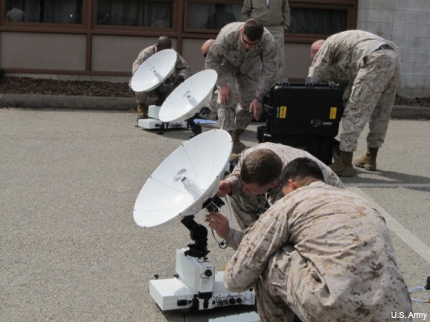Army boosts bandwidth with new suitcase-sized satellite terminals
T2C2, now a program of record, takes portable battlefield communications from kilobits to megabits per second.

Portable network access for soldiers in the field is about to get a lot faster with the Army’s latest satellite kit in a suitcase.
The Transportable Tactical Command Communications, or T2C2, boosts the bandwidth for small detachments and teams connecting to the Army’s battlefield network, thus increasing the situational awareness and functionality of early-entry teams and helping to improve communications throughout the tactical edge, the Army said in a release.
T2T2 comes in two flavors: a larger transportable dish that serves company-level operations and the smaller T2C2 Lite, which the Army said is about the size of carry-on luggage and which can be set up and working in about 10 minutes.
The small model is similar to the Global Rapid Response Information Package, or GRRIP, which soldiers have been using in Afghanistan, for example, as network infrastructure leaves with the drawdown. But GRIPP uses only the L Band in the satellite communications spectrum, limiting transmission to kilobits per second. T2C2 Lite adds the Ka and X bands, boosting performance to megabits per second and allowing soldiers to use advanced applications. Last month, T2C2 was designated a program of record (GRRIP is not), enabling the Army to institutionalize training on the system.
The equipment connects to the Army’s battlefield network, the Warfighter Information Network-Tactical, via the military’s Wideband Global SATCOM constellation, and will work as a companion to the Enroute Mission Command Capability, a WIN-T program that gives rapid-response forces a view of their drop zones and allows for mission planning while in flight.
For the Army, the bigger bandwidth, combined with T2C2’s portability, advances the cause of seamless, mobile battlefield communications.
"The T2C2 program is the Army's mechanism for capturing the innovation that's been evolving in the small satellite dish market sector, which the Army has been leveraging through operational needs statements for years," said Lt. Col. Joel Babbitt, product manager for WIN-T Increment 1, which manages the T2C2 program.
The larger version of T2C2 provides high-bandwidth communications for small companies and forward operating bases, and builds on the capabilities of the Secure Internet Protocol Router/Non-secure Internet Protocol Router Access Point (SNAP) satellite terminals currently in use. The Army expects to continue using GRRIP and SNAP terminals—upgrading SNAPs returning from the field with the Ka and X bands—while transitioning fully to T2C2.
"T2C2 directly addresses the Army's current priorities of becoming a more expeditionary, scalable and capable force," Babbitt said. "Additionally, by providing continued higher capacity network communications to the most remote locations, we're enabling much more robust situational awareness and mission command capabilities for smaller units dispersed throughout a broader battlespace."



